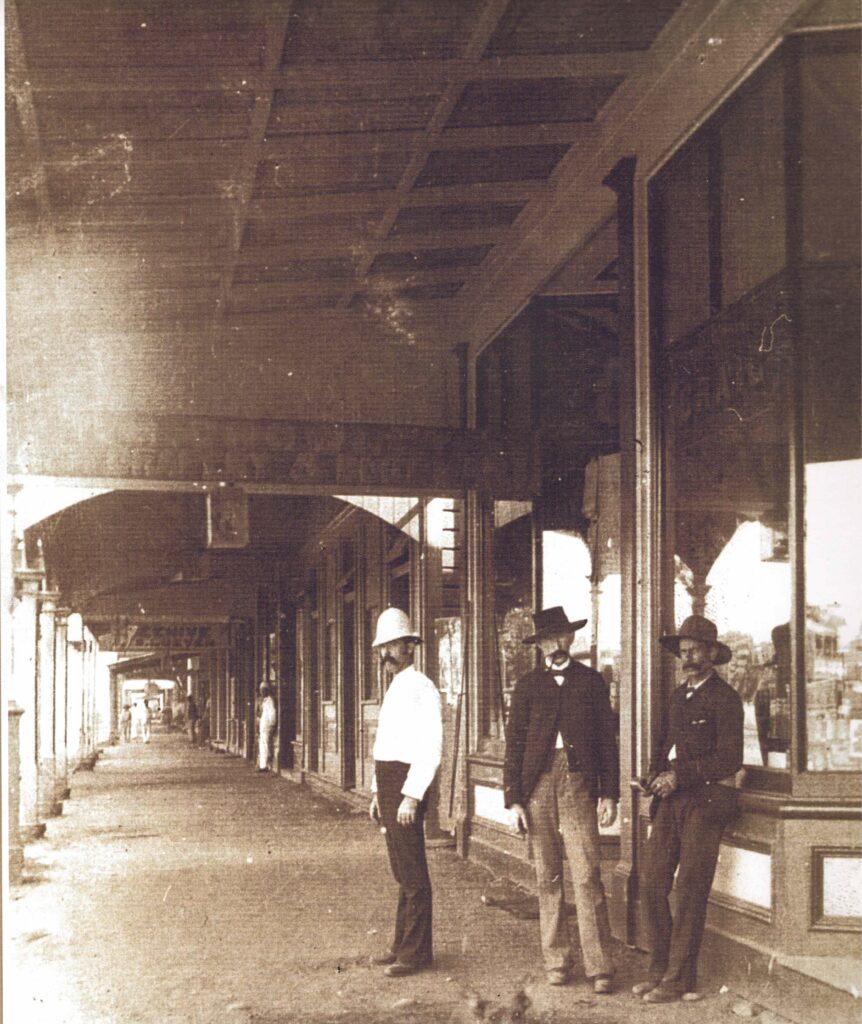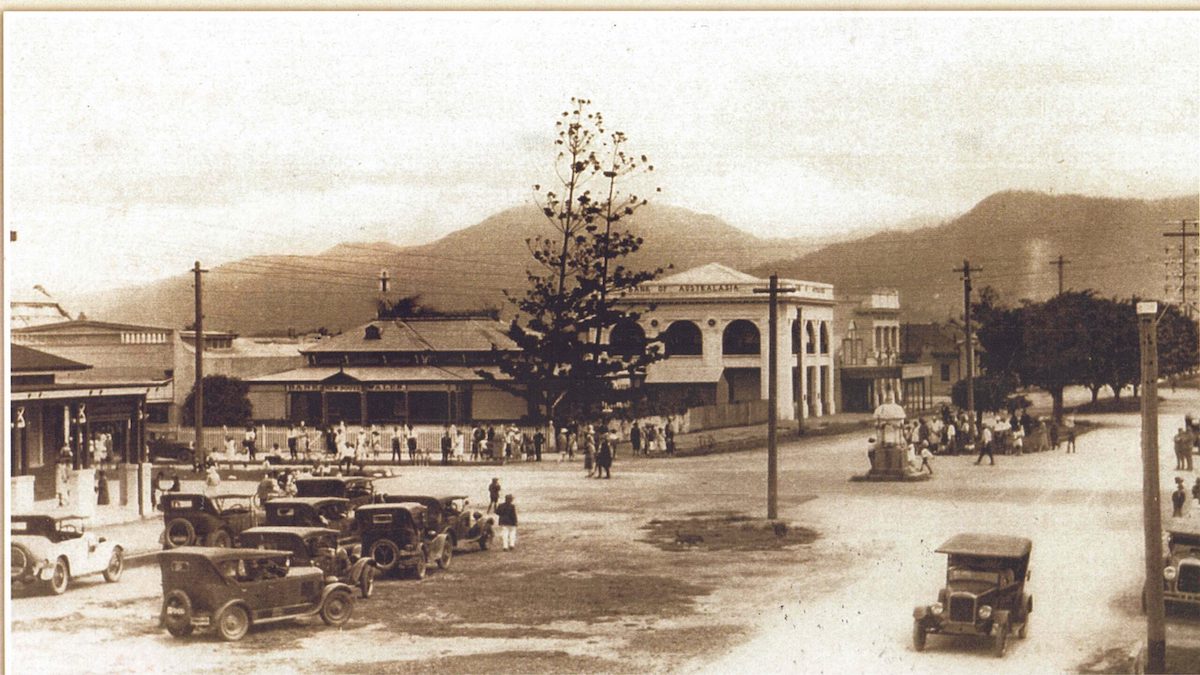Table of contents
- Cairns History Facts
- When was Cairns Founded?
- Cairns History: Name Origin
- Why was Cairns Established?
- Where is Cairns on the Map?
- Cairns History Timeline
- Cairns History Map
- Old Pictures of Cairns
- Cairns History Museum
- Cairns Population
- McLeod Street Pioneer Cemetery and Cairns History
- What is Cairns Famous for?
Cairns History Facts
We look at Cairns history and provide links to various material from Cairns past. There are also links to some of our other work (mainly post European arrival) that we hope you find interesting or at least entertaining.
However, it is important to remember that the Gimuy Walubara Yidinji are the traditional owners and custodians of this area. Indeed they refer to Cairns as Gimuy. Consequently, we acknowledge their past struggles and success.
Aboriginal Australians of Cairns and the surrounding rainforests call themselves the Bama people. Despite the frontier wars during the period of early contact, and the racist policies of the past, the Bama people have endured and maintained their cultural heritage.
The Gimuy Walubara Yidinji are the original owners or custodians of this area. Today they are referred to as the Traditional Owners.
When was Cairns Founded?
Cairns was officially founded in 1876. The area was previously known as Trinity Bay by Europeans and as Gimuy by the Traditional Owners.
Cairns History: Name Origin
In 1876 the new settlement of Cairns was named after the Queensland Governor at that time, Sir William Wellington Cairns. The settlement was later declared a town in 1903.]
Why was Cairns Established?
Initially, Cairns was established for the miners who worked the Hodgkinson River goldfields.
However, after an easier track to the goldfields was discovered from Port Douglas, Cairns became a rail port exporting sugar cane, gold, precious metals and other agricultural based products.
The fertile soil on the Atherton Tableland were perfect for farming and remains a major source of fresh produce for Australia. In addition, sugar cane farms were developed on the lowlands around Cairns as there was now access to transport the cane to the southern sugar mills.
Where is Cairns on the Map?
Cairns History Timeline
Here’s a timeline of significant events in the history of Cairns:
- 1770: Captain James Cook sights the area now known as Cairns during his voyage along the east coast of Australia.
- 1876: Christie Palmerston establishes a settlement at the mouth of Trinity Inlet, named after the Governor of Queensland, Sir William Wellington Cairns.
- 1882: The construction of a railway to Herberton begins, leading to increased development in the area.
- 1885: Cairns is officially declared a port of entry.
- 1890s: The discovery of gold in the Hodgkinson River area sparks a gold rush, leading to a population boom in Cairns.
- 1903: Cairns becomes a municipality.
- 1910s: The sugarcane industry becomes prominent in Cairns and surrounding regions.
- 1923: Cairns is connected to Brisbane by rail, further boosting its growth and economic importance.
- World War II era: Cairns serves as a strategic military base for Australian and Allied forces in the Pacific.
- 1970s: The tourism industry begins to flourish in Cairns, particularly with the development of the Great Barrier Reef as a major tourist attraction.
- 1980s: Cairns experiences rapid development and expansion, with infrastructure improvements and increased tourism.
- 2000s: Cairns faces challenges such as environmental concerns regarding the Great Barrier Reef and economic shifts, but continues to be a popular destination for tourists and a hub for the tropical north of Queensland.
- 2010s-present: Cairns continues to evolve, with ongoing efforts to balance economic development with environmental conservation, and to diversify its economy beyond tourism.
This timeline highlights Cairns’ transformation from a small settlement to a thriving city with a diverse economy and a strong tourism industry.
History of Queensland Timelines are available for purchase. Using timelines in the classroom is a key requirement of the Australian HASS curriculum.
Cairns History Map
Some people love old maps of Cairns. So we were delighted to find Old Maps Online with many great maps from Cairns past.
Below is one of the first survey maps of what was the new town of Cairns.

Cairns History pdf
By buying and using these History of Queensland Timeline posters you will not only be meeting history requirements but you will also have a great display.
Cairns City of the South Pacific A History 1770 – 1995
The most comprehensive historical account of Cairns is Cairns City of the South Pacific A History 1770 – 1995 by Timothy Bottoms.
This work covers the many and varied people who have lived and worked in the district, as well as the dramatic changes that have occurred. As a result, it is a fascinating coverage of this unique tropical city.
Tim’s work is accessible and interesting to all levels of readers and listeners. Tim is an intrepid author and narrator who has a cosmopolitan approach and yet artfully allows the many historical voices and faces to speak for themselves.
Old Pictures of Cairns
While this page links to many aspects of Cairns history, it is the old pictures of Cairns that people enjoy the most.
You will find links to old pictures of Cairns streets as well as pictures of the Cairns Esplanade.
Indeed these pictures are a useful way to show the past. We have pictures of Cairns in flood, as well as other images that highlight the city’s built history and cultural diversity.

Cairns History Museum
The Cairns Museum and the Cairns Historical Society Research Centre are located in the Cairns School of Arts building, in the heart of the Cairns CBD. The Cairns Museum is owned and operated by the Cairns Historical Society.

Cairns Historical Society
However, the Society’s extensive archival and photographic collections are open to anyone with a research interest in Cairns or Far North Queensland. So if you have an interest in history, you should get in contact.
Bookings are required to visit the Research Centre and access the collection. Email research queries are welcome.
Cairns Population
Cairns has experienced notable population growth due to its appealing lifestyle, economic opportunities, and status as a prominent tourist destination. Below is a detailed overview of the population growth in Cairns:
- Post-World War II Expansion: After World War II, Cairns began to grow steadily, driven by improvements in infrastructure such as the expansion of the Cairns Airport and better road connectivity. This period marked the beginning of Cairns’ transformation into a regional hub.
- 1980s and 1990s Boom: The 1980s and 1990s saw rapid population growth, primarily due to the city’s development as a major tourism center. The promotion of the Great Barrier Reef and the Daintree Rainforest, along with the construction of resorts and increased international flights, attracted both tourists and permanent residents.
- 2000s to Present: Population growth continued into the 2000s, bolstered by ongoing tourism, a strong service sector, and Cairns’ reputation as a desirable place for retirees and families. By 2024 the population of Cairns was approximately 175 000.
Future Outlook and Projected Growth:
- Cairns is expected to continue growing, with projections indicating that the population could reach around 200,000 by 2036, depending on various factors such as economic conditions and migration trends.
- Planning and Development:
- Local government and planning authorities are focused on sustainable development to accommodate this growth. This includes creating more residential areas, improving infrastructure, and ensuring environmental conservation.
Cairns’ population growth is driven by its appeal. While this growth brings challenges, ongoing planning and sustainable development efforts aim to ensure that Cairns continues to thrive as a vibrant and attractive place to live and visit. By addressing housing, infrastructure, and environmental concerns, Cairns can maintain its growth trajectory in a sustainable and balanced manner.
McLeod Street Pioneer Cemetery and Cairns History
The heritage listed McLeod Street Pioneer Cemetery, Cairns, was used for interment from 1877 until 1949.
The McLeod Street Pioneer Cemetery has endured as the resting
place of over two thousand five hundred people of diverse ethnic and
occupational backgrounds.
I found the grave of John Samuel Pyne who was a good runner, horseman, butcher and my great uncle. He died in 1890 (aged 21) when he fell riding his horse ‘pickpocket’ on the Cairns Esplanade.

What is Cairns Famous for?
Cairns, located in tropical North Queensland, Australia, is famous for being a gateway to the Great Barrier Reef, one of the world’s natural wonders. It’s also renowned for the Daintree Rainforest, part of the Wet Tropics World Heritage Area. Cairns attracts adventure seekers with activities like snorkeling, diving, and bungee jumping.
The city is celebrated for its Esplanade Lagoon, vibrant markets, and proximity to stunning landscapes like the Atherton Tablelands and Kuranda Scenic Railway. It’s a hub for tropical biodiversity and eco-tourism
Cairns History Links
Far North Qld
Far North Queensland was a long way from anywhere as far as the modern world was concerned, so it developed a distinct environment and culture.
Cairns Flooding
Cairns flooding should surprise no-one. After all, Cairns is a tropical city in Far North Queensland. However climate change is making the problem worse.
Old Pictures of Cairns
Old Pictures of Cairns links to a number of pictures of Cairns past that we hope you enjoy.
Struggle&Resistance
Rob Pyne’s Struggle and Resistance in the Far North, is a glimpse into Far North Queensland politics, history and culture. Further, it is an account of the region’s hidden stories and prominent identities.
Qld Political Culture
Queensland political culture provided an interesting and sometimes uncomfortable backdrop to my life growing up. After all, these were deeply Conservative times.
Cairns City Council
Cairns City Council was a municipality in Far North Queensland. Indeed it was established in 1885 and merged with the Mulgrave Shire Council in 1995, becoming part of Cairns history.
Cairns Regional Council
Control of the Cairns City Council had alternated between administrations which supported ‘development at all costs’ and those which had more of a commitment to fairness and the environment.
Tom Pyne
Tom Pyne was born in the town of Babinda in 1935. Furthermore, he was the youngest of five children born to John Samuel and Katherine Hannah Pyne.
Rob Pyne
Rob Pyne was born in Gordonvale and raised in Edmonton, south of Cairns. He was born to Tom Pyne and his wife Marion. Rob campaigned for social justice, including disability rights.
Relevant Material
- Cairns Facts
- Aboriginal and Torres Strait Islander People
- Cairns Humidity
- Cairns Postcode
- Far North Queensland
- Gimuy
- Growing up in Australia
